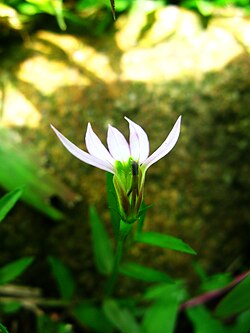Lobelia chinensis
| Lobelia chinensis | |
|---|---|

| |
| Flower of Lobelia chinensis | |
| Scientific classification | |
| Kingdom: | |
| (unranked): | |
| (unranked): | |
| (unranked): | |
| Order: | |
| Family: | |
| Genus: | |
| Species: | L. chinensis
|
| Binomial name | |
| Lobelia chinensis | |
| Synonyms | |
| |
Lobelia chinensis, commonly known as the Chinese Lobelia, Herba Lobellae Chinensis, aze mushiro, and mizo kakushi,[1] is a species of flowering plant in the family Campanulaceae. It is one of the 50 fundamental herbs used in traditional Chinese medicine, where it has the name (Chinese: 半边莲; pinyin: bàn biān lián).[2]
Description
L. chinensis is a small perennial herb[3] that grows in tangled clumps from 15 centimetres (5.9 in) to 35 centimetres (14 in) long. It has a long, thin, branching stem that is olive green and green-brown crumpled narrow leaves. It has little to no odor and a sweet and pungent taste. When harvesting herbs for medical use, the ones with the greenest stems and yellower roots are preferred.[2]
Distribution
It is endemic to east, south, southwest, and south-central China.
Herbal medicine
L. chinensis is considered one of the 50 fundamental herbs in Chinese herbology. Historically, L. chinensis has been used in herbal medicine to help stop smoking,[citation needed] however the Food and Drug Administration has banned the use of herbs containing lobeline.[citation needed]
Chemical constituents
L. chinensis contains 6,7-dimethoxycoumarin, fraxinol, 5-hydroxy-7-methoxycoumarin, tomentin, 3'-hydroxygenkwanin, apigenin, quercetin, luteolin, linarin, luteolin 3',4'-dimethylether-7-O-beta-D-glucoside, isoferulic acid, and ethyl rosmarinate.[4]
Toxicity and adverse effects
L. chinensis is considered mildly toxic[1] due to its adverse effects, including vomiting, heartburn, anxiety, vibrating, eclampsia, increased heart-rate, and severe stomach aches.[5]
References
- ^ a b c "Taxon: Lobelia chinensis Lour". NPGS/GRIN. Retrieved 2008-02-11.
- ^ a b "Lobelia Herb (Ban Bian Lian)". Chinese Herbs Healing. 2008.
{{cite web}}:|access-date=requires|url=(help); Missing or empty|url=(help) - ^ "Lobelia chinensis Lour. - Chinese lobelia". United States Department of Agriculture. Retrieved 22 February 2014.
- ^ Chen JX, Huang SH, Wang Y, Shao M, Ye WC (2010). "Studies on the chemical constituents from Lobelia chinensis". Zhong Yao Cai. 33 (11): 1721–4. PMID 21434431.
- ^ Han J, Zhang F, Li Z, Du G, Qin H (2009). "[Chemical constituents of Lobelia chinensis]". Zhongguo Zhong Yao Za Zhi (in Chinese). 34 (17): 2200–2. PMID 19943485.
